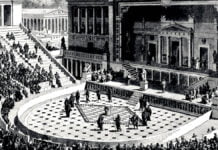Meter refers to the structured rhythm of a poem, determined by the pattern of stressed (ˈ) and unstressed (˘) syllables. It forms the backbone of many forms of poetry, contributing to its musical quality and emphasising particular words or themes. The meter is determined by the number of feet in a line and its structure. Foot/feet, in poetic terms, is a measuring unit, a single group of syllables in a poem. One needs to identify the number and type of syllables and their stress patterns to identify the meter of a poem. The meter of a poem, in turn, will help to determine the type or structure of a poem.
Iambic Pentameter
Definition: A line of verse with five metrical feet, each consisting of an unstressed syllable followed by a stressed syllable (˘ˈ).
Pattern: da-DUM da-DUM da-DUM da-DUM da-DUM / ˘ˈ ˘ˈ ˘ˈ ˘ˈ ˘ˈ
Iambic Pentameter is the most common meter in English poetry. It consists of five metrical feet called “iambs”. An iamb is a two-syllable unit with an unstressed syllable followed by a stressed syllable (da-DUM). So, a line of iambic pentameter has ten syllables arranged in five iambs.
E.g., But soft, what light through yonder window breaks?
˘ ˈ ˘ ˈ ˘ ˈ ˘ ˈ ˘ ˈ
(from Shakespeare’s Romeo and Juliet)
Iambic Pentameter mimics natural speech rhythms, making it versatile for various poetic forms.
Heroic Couplet
Definition: A pair of rhyming iambic pentameter lines.
Pattern: Each line follows the iambic pentameter pattern (da-DUM da-DUM da-DUM da-DUM da-DUM / ˘ˈ ˘ˈ ˘ˈ ˘ˈ ˘ˈ), and the end words rhyme (aa, bb, cc, etc.).
Heroic Couplet is a rhyming pair of lines written in iambic pentameter. The two lines rhyme with each other, creating a solid sense of closure and completeness.
E.g., True wit is nature to advantage dressed,
What oft was thought, but ne’er so well expressed.
˘ ˈ ˘ ˈ ˘ ˈ ˘ ˈ ˘ ˈ
˘ ˈ ˘ ˈ ˘ ˈ ˘ ˈ ˘ ˈ
(from Alexander Pope’s Essay on Criticism)
Heroic Couplet is often used for satirical or didactic poetry due to its balanced, epigrammatic quality.
Blank Verse
Definition: Unrhymed iambic pentameter.
Pattern: da-DUM da-DUM da-DUM da-DUM da-DUM / ˘ˈ ˘ˈ ˘ˈ ˘ˈ ˘ˈ, but without end rhyme.
Blank Verse is unrhymed iambic pentameter. It utilises the rhythm of iambic pentameter to create a sense of flow and musicality but forgoes end rhymes for a more subtle effect.
E.g., Of man’s first disobedience, and the fruit
Of that forbidden tree whose mortal taste
Brought death into the world, and all our woe,
˘ ˈ ˘ ˈ ˘ ˈ ˘ ˈ ˘ ˈ
˘ ˈ ˘ ˈ ˘ ˈ ˘ ˈ ˘ ˈ
˘ ˈ ˘ ˈ ˘ ˈ ˘ ˈ ˘ ˈ
(from John Milton’s Paradise Lost)
Blank Verse offers the meter structure without the constraints of rhyme, allowing for more natural-sounding dialogue in plays.
Free Verse
Definition: Poetry that does not adhere to a regular meter or rhyme scheme.
Pattern: Varies; lines can have any length and number of syllables.
Free Verse rejects traditional meter and rhyme schemes. It focuses on creating rhythm and musicality through variations in word choice, sentence structure, and pauses. Free verse allows for more flexibility and experimentation in expressing emotions and ideas.
E.g., The fog comes
on little cat feet.
It sits looking
over the harbour and city
on silent haunches
and then moves on.
(From Carl Sandburg’s Fog)
Free Verse allows poets greater freedom of expression, focusing on the natural rhythms of language rather than adhering to strict metrical rules.
Comparison and Usage
Iambic Pentameter is often used for its natural rhythm and versatility, making it suitable for various poetic forms and dramatic works.
Heroic Couplets provide a structured, rhyming format that lends itself to wit, clarity, and memorability, often used in satirical and didactic poetry.
Blank Verse maintains the formal meter of iambic pentameter but without rhyme, offering a balance between structure and flexibility, commonly found in epic and dramatic works.
Free Verse offers the most freedom, abandoning regular meter and rhyme to allow for a more conversational or experimental approach, favoured in modern and contemporary poetry.
Key Differences
Structure
Iambic pentameter and heroic couplets have strict metrical patterns, blank verse has a metrical pattern, but no rhyme, and free verse has neither fixed meter nor rhyme.
Rhyme
Heroic couplets rhyme, while the others don’t necessarily rhyme.
Flexibility
Free verse offers the most flexibility, while heroic couplets are the most structured.
Historical Usage
Iambic pentameter, heroic couplets, and blank verse are more associated with traditional poetry, while free verse is more modern.
Each of these forms has its strengths and is chosen by poets based on the effect they want to achieve, the content they convey, and the traditions they work within or against. Understanding these forms is crucial for appreciating the technical aspects of poetry and how form interacts with content to create meaning. Iambic pentameter provides a natural rhythm miming human speech, while heroic couplets offer a sense of order and finality. Blank verse allows for more flexibility within the structure, and free verse breaks free from constraints to create a unique voice.





























